Artificial Intelligence is changing SEO, creating a mix of new challenges and opportunities that are forcing marketers and developers to rethink their strategies. This shift is changing how we approach search engine optimization and content creation. This article explores the impact AI is really having in many areas of this common practice, including:
- How SEO and its strategies have changed
- The identity crisis SEO is facing because of these changes
- Key Google updates and their effects
- Improvements made to programmatic SEO
- The best SEO tools
- How Builder creates SEO-friendly apps and sites
Let’s dive in. Starting with some cliches, so we can get that out of the way.
I know, I know, "SEO is dead" is super cringe at this point that it almost hurts to type it. But everywhere I turn, it’s there to scare you into thinking SEO isn’t important anymore. Rest assured, I’m here to debunk that theory.
Here’s an interesting market trend from Jake Ward at Contact Studios that depicts the death of SEO for the past 27 years. He also shares the reality of things with 8.5B daily searches and SEO being a $1B industry.
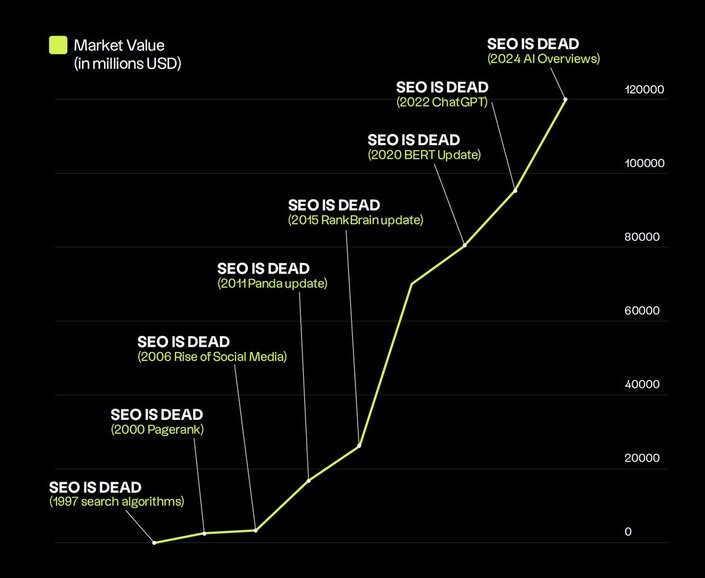
This constant cycle of "X is dead, long live Y" in tech can be exhausting. It creates a feeling similar to FOMO or imposter syndrome, that nagging feeling that you're somehow missing out or faking it -- even when you've put in the work.
Developers understand imposter syndrome, as a developer I feel this too. Take React, for instance. You spend months getting comfortable with it, building components, managing state, and feeling pretty good about your skills. Then suddenly, everyone's talking about Vite and how it's the next big thing. Should you drop everything and learn Vite? Is React dead now?
This constant cycle of learning and re-learning can make even seasoned developers feel like they're always one step behind.
SEO's kind of like that. It keeps evolving, but the core principles stick around. With all these changes, it creates a sense of imposter syndrome. You think you’ve finally figured the game out, and then the next thing comes along. But It's not about gaming the system. It's about creating solid, valuable content that people actually want to read or use. That's still super important, AI or no AI.
So, no, SEO isn't dead. It's just growing up, and we need to grow with it. Let's look at how AI is shaking things up in the SEO world and what that means for anyone trying to get their content seen online.
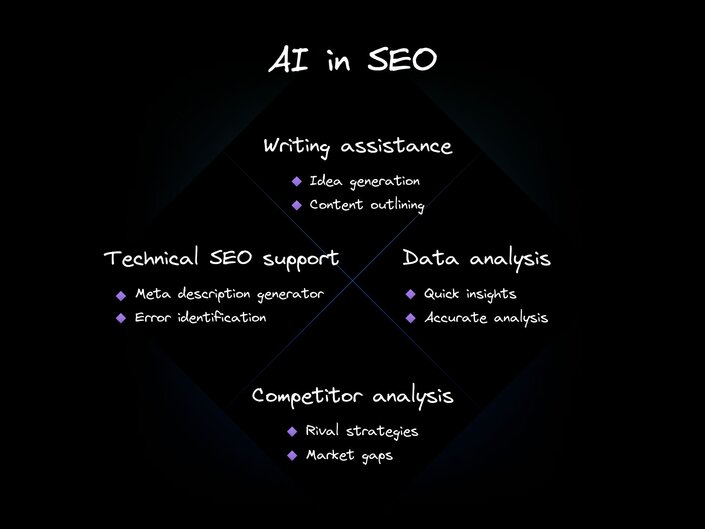
AI is a game changer; just kidding! But in reality, AI is quickly becoming a valuable tool for SEO experts.
Search engines use AI to understand user intent better, shifting the focus from exact keyword matches to valuable content creation.
AI tools are helping with various aspects of SEO:
- Writing assistance for idea generation and content outlining
- Data analysis for quicker, more accurate insights
- Technical SEO support for routine tasks like meta description generation and error identification
- Competitor analysis, providing deeper insights into rival strategies and market gaps
AI is expanding strategies that SEOs didn’t have to think of prior. The ideal situation is the ability to effectively use AI tools, combined with human creativity and strategic thinking, to expand your reach.
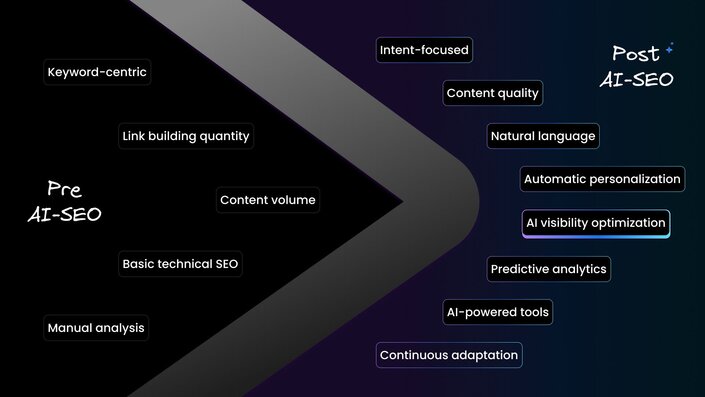
Pre-AI SEO strategy:
- Keyword-centric: Heavy focus on exact-match keywords, keyword usage, and keyword difficulty
- Link building: Emphasis on quantity over quality of backlinks
- Content creation: Often prioritized monthly search volume over depth
- Technical SEO: Basic on-page optimization and site structure
- Manual analysis: Time-consuming data interpretation and competitor research
Post-AI SEO strategy:
- Intent-focused: Understanding and matching user search intent
- Produce high-quality content: Emphasis on comprehensive, expert-level content
- Natural language processing: Optimizing for conversational queries and voice search
- AI-powered tools: Utilizing machine learning for target keyword research and content optimization
- Predictive analytics: Using AI to forecast trends and adjust strategies proactively
- Automated personalization: Tailoring content and user experience based on AI insights
- Continuous adaptation: Regularly updating strategies to align with AI-driven algorithm changes
- AI visibility optimization (AIVO): Making content more visible and understandable to AI search engines
AIVO is the strategy I’m really interested in. As AI search engines like ChatGPT, Google Gemini, Claude, and Perplexity start eating into the typical search engines, we need to start thinking of how brands are surfacing there.
The key shift here is from manipulating search engine algorithms to focusing on user experience and content value. AI has made search engines smarter at understanding context and user intent, pushing us to create genuinely helpful, high-quality content rather than just optimizing for keywords.
Programmatic SEO is a way to automatically create many web pages, each targeting specific search terms. It's like having a robot write hundreds or thousands of articles for you, but each one is tailored to a particular topic or location.
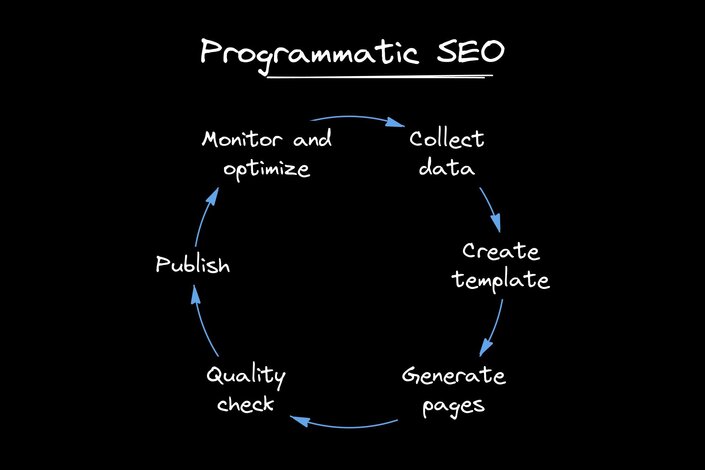
Here's the basic idea:
- Collect a bunch of data (like product info or city names)
- Make a template for your pages
- Use code to fill the template with your data, creating many pages
- Check that the pages make sense
- Publish them all to your website
It's great for businesses with:
- Tons of products
- Services in many locations
- Large databases of information
The Good:
- Efficiently targets long-tail keywords
- Scales content creation for large websites
- Provides useful information for niche queries
- Helps businesses with large catalogs or location-based services
The Bad:
- Risk of creating low-quality, repetitive content
- Can lead to thin content if not done carefully
- Might be seen as manipulative by search engines
- Can flood search results, potentially pushing out smaller, manual content creators
How AI is improving programmatic SEO:
- Generates more natural, varied content that reads like human-written text
- Uses advanced data analysis to identify valuable keyword opportunities
- Personalizes content based on user intent and preferences
- Implements real-time optimization and quality control
- Integrates multi-media elements more effectively
- Enhances content relevance and readability
The key is balance. AI is helping programmatic SEO evolve from a potential spam tactic to a sophisticated content strategy. When done right, it can provide valuable, tailored content for users searching for specific information.
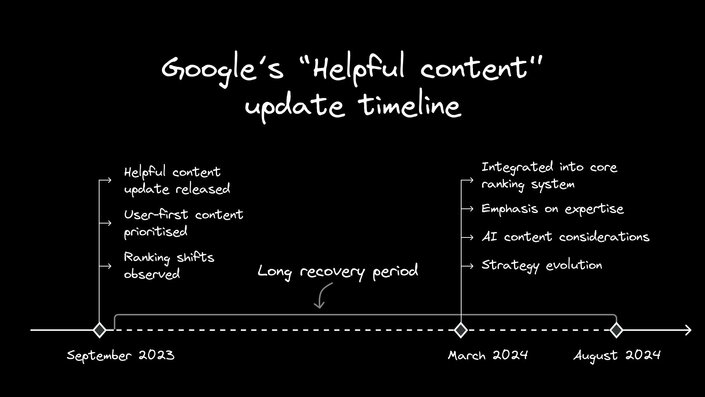
Back in September 2023, Google released a significant update - “Helpful Content,” which altered SEO practices. Here's how it has affected the industry:
- User-first content: Google began prioritizing content that provides genuine value to users rather than content solely optimized for search engine results.
- Ranking shifts: Many sites, especially those with content primarily created for SEO, experienced noticeable drops in organic traffic and search rankings.
- Long recovery period: Some sites affected by this update have struggled to regain their previous positions, with recovery efforts continuing well into 2024.
- Core system integration: In March 2024, Google integrated the helpful content system into its core ranking system, solidifying its importance.
- Emphasis on expertise: Content demonstrating first-hand experience and deep knowledge has been increasingly favored.
- AI content considerations: The focus shifted to content helpfulness, regardless of the creation method. However, mass-produced AI content for SEO purposes has often underperformed.
- Strategy evolution: SEOs have had to prioritize creating genuinely helpful, original content over traditional keyword optimization tactics.
The helpful content update and subsequent changes sparked controversy in the SEO community. Google's vague guidelines and limited communication frustrated site owners, leaving them unsure of how to recover. AI-generated content and forum posts in search results raised questions about the update's effectiveness. These issues have led to ongoing debates about Google's algorithmic approach and its impact on content creators and searchers.
However, this update pushed the SEO industry towards a more user-centric approach, aligning SEO strategies more closely with content marketing principles. While challenging for many, it has aimed to improve the overall quality of search results for users.
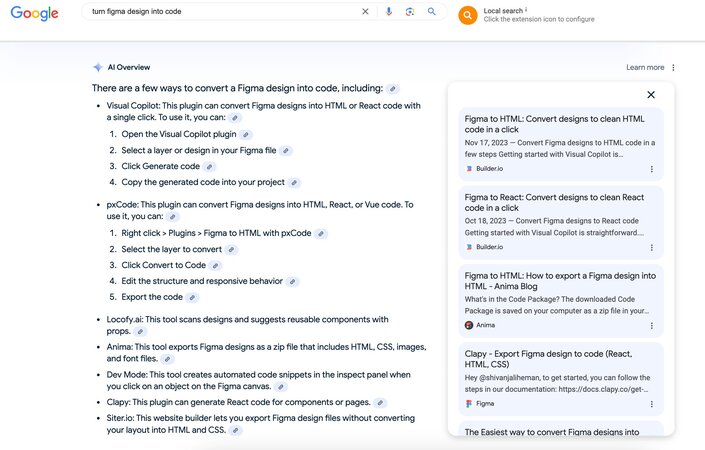
As AI gets smarter, it changes how we do SEO. One big change is the rise of Featured Snippets and AI Overviews. These are like the cool kids of search results - they get special treatment and prime real estate on the search page.
What are AI Overviews?
AI Overviews are a newer feature from Google. They're like feature snippets on steroids. Instead of pulling info from a single source, AI Overviews synthesize information from multiple high-quality sources to give a comprehensive answer to a query. They're designed to provide a quick, authoritative summary without the need to click through to multiple websites.
To optimize content for AI Overviews:
- Write really good, in-depth content. Cover all the angles.
- Stick to facts. Don't make stuff up.
- Organize your content well. Use headings and lists.
- Build your site's reputation over time.
- Keep your content up-to-date.
- Generate schema markup to help Google understand your content.
- Focus on answering questions people are asking.
- Show you know what you're talking about.
Remember, there's no magic trick here. It's mostly about creating great content that's useful to people. If you're doing that, you're on the right track for both regular SEO and these new AI features.
Featured snippets, on the other hand, are those boxes at the top of search results that give you a quick answer. They flip the script on regular results by showing the description first. You might also spot them in the "People Also Ask" section.
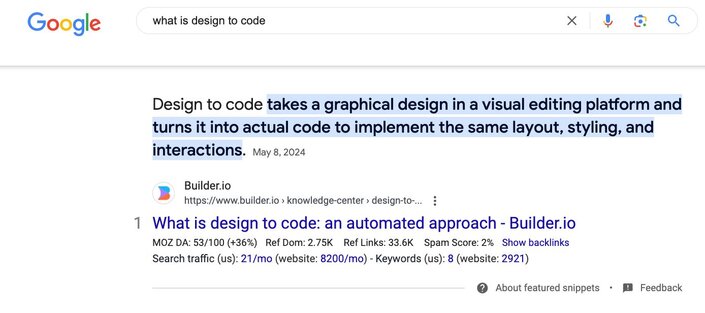
Here's a quick breakdown of how feature snippets work:
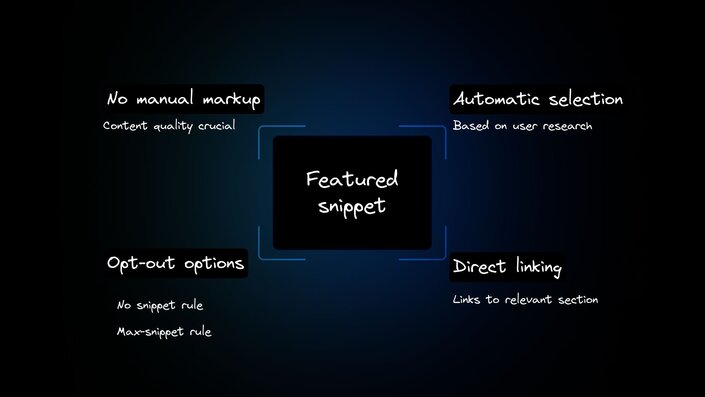
Some key things to know about featured snippets:
- Google picks them automatically based on what people are searching for.
- Clicking on one takes you straight to the relevant part of the page.
- If you don't want your content in snippets, you can opt-out with some technical tweaks.
- There's no secret handshake to get your page chosen as a snippet - it's all about the quality of your content.
With AI getting better at understanding context and what users want, these snippets are getting smarter, too. This means creating clear, to-the-point content that answers questions directly is more important than ever for SEO.
While Google doesn't allow direct markup for featured snippets, you can increase your chances:
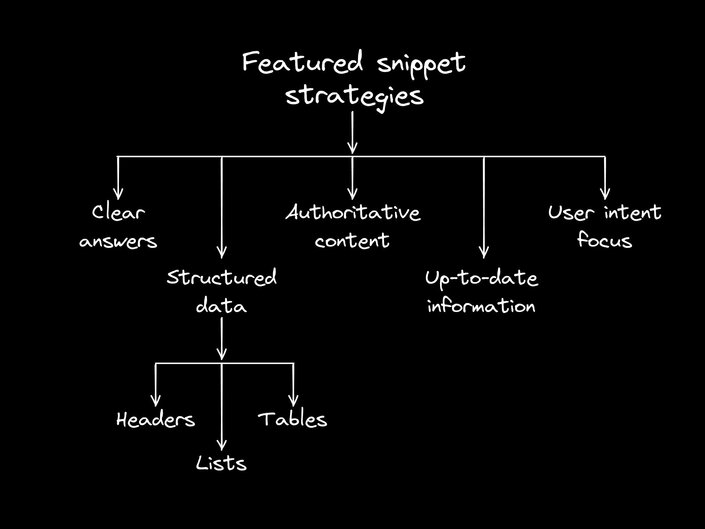
- Answer specific questions clearly and concisely
- Use structured data and clear formatting (headers, lists, tables)
- Create high-quality, authoritative content
- Keep information up-to-date and comprehensive
- Focus on satisfying user intent
Remember, Google ultimately decides which content to feature based on what best serves user needs. These strategies can help, but there's no guarantee of being featured.
Here are some standout AI-powered SEO tools that can help in various ways, from AI writing tools to auditing a website's performance.
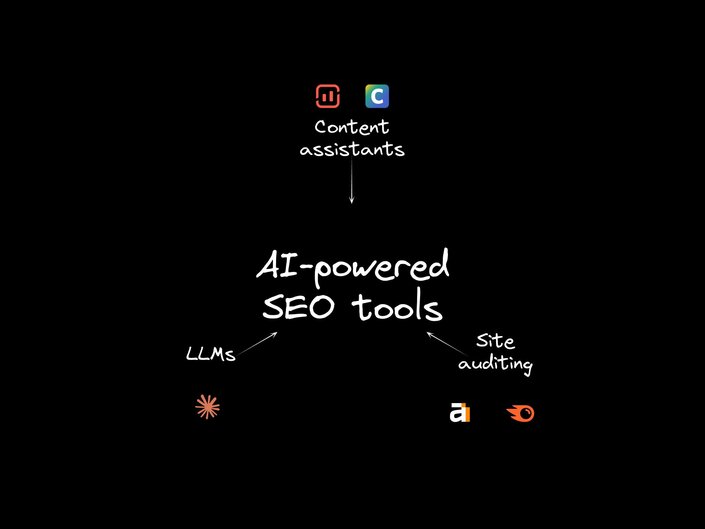
- Surfer SEO: combines AI-powered content creation with SEO optimization, allowing users to generate high-quality, ready-to-rank articles in minutes while analyzing competitors and optimizing for search intent across multiple languages. Side note - you can connect your Google Search Console, which will help with internal linking as you generate content.
- Clearscope: an advanced SEO tool that uses artificial intelligence to analyze top-ranking content, provide keyword suggestions, and offer real-time optimization guidance to help create highly relevant, search engine-friendly articles. Create optimized content or specific SEO content easily. They even have a fun Google Docs plugin to make the content creation process smoother.
- Ahrefs: integrates AI into its SEO toolkit to automate keyword research, analyze search intent, grade content, translate keywords, and fix technical issues, streamlining the entire SEO workflow.
- Semrush: very similiar to Ahrefs but also has an AI Writing Assistant to help create SEO-optimized content, from ideation to final drafts, with real-time optimization suggestions.
- Claude: I know I’m not including ChatGPT in this list and they do a fine job. But in my experience, Claude has an edge in content creation, keyword research, and SEO strategy development. The more I work with technical teams, the more I see them adopting Claude as an AI tool over ChatGPT, at least for now.
As an SEO professional, I've come to appreciate AI SEO software for their ability to provide deep insights and handle repetitive tasks. I often recommend Ahrefs and SurferSEO, but there are many options available. Part of the enjoyment - and the challenge - is finding the right mix of tools for your specific needs. I’m a bit of a tool junkie and can find myself going down rabbit holes, but I do warn you, these aren't free AI SEO tools. Try to remember that these tools enhance our capabilities, but it's our collaboration with team members, strategic thinking, and understanding of our audience that ultimately drives SEO success.
Builder.io is built with SEO in mind. It gives you tools to create search-friendly content without making things complicated. Here's how Builder helps with SEO and site performance:
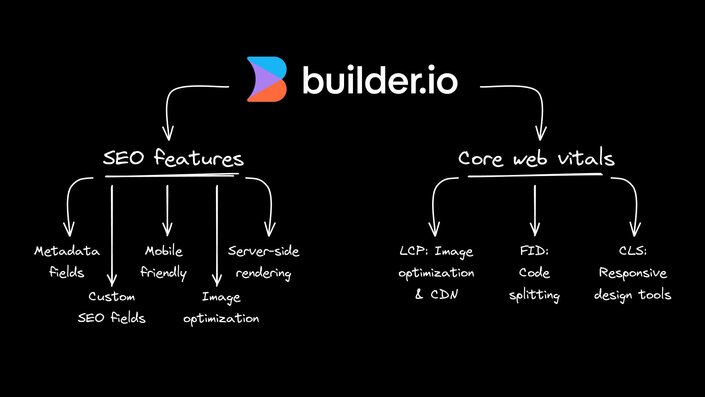
- Metadata Fields: Builder's default Page Model includes meta titles and meta descriptions. Always fill these out - they're crucial for search engine optimization.
- Custom SEO Fields: You can add your own fields for things like noindex or nofollow tags.
- Mobile-Friendly: Builder's styles work well on mobile by default, which Google loves.
- Image Optimization: Builder automatically optimizes images when you use its Image block or API. This helps your pages load faster.
- Server-side Rendering: Builder works with frameworks that render pages on the server, which can boost your SEO.
Builder helps with Google's Core Web Vitals in a few ways:
- Largest Contentful Paint (LCP): Builder's automatic image optimization and CDN delivery help large images load faster, improving LCP scores.
- First Input Delay (FID): Builder's SDKs support code splitting out-of-the-box, which can reduce JavaScript execution time and improve FID.
- Cumulative Layout Shift (CLS): Builder's responsive design tools and preview features help you create stable layouts that don't shift unexpectedly as the page loads.
Tip: Read more about Builder and Core Web Vitals.
- Use Proper Headings: Set your Text Blocks as H1, H2, etc. when appropriate.
- Optimize Images: Use Image blocks and add good alt text.
- Create a Sitemap: You can use Builder's API to make a sitemap.
- Check Performance: Use tools like Google Lighthouse or PageSpeed Insights to monitor your site's speed. We’ve even built this pretty cool performance tool, Performance Insights.
By leveraging these features and following these practices, you'll be well on your way to creating SEO-friendly sites with Builder.io.
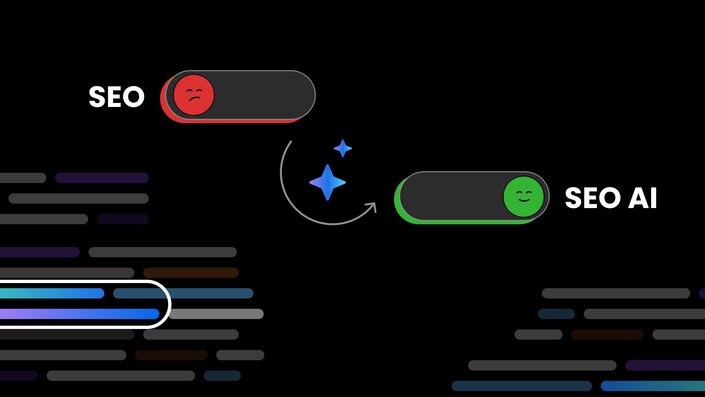
So, is it SEO or content marketing with a side of tech optimization? It’s not one or the other, in reality it’s a partnership that should be a primary focus.
The "new" SEO strategy isn't new at all. It's what good marketers have been doing for decades: focusing on customer needs and aiming for ROI.
Think about it:
- Creating content that answers user questions? That's just good copywriting.
- Focusing on user intent? That's basic customer service.
- Building authority in your niche? Welcome to Brand Building 101.
AI hasn't revolutionized SEO, it has just double-downed on the prior strategies, while heavily weighing on helpful content with a couple new focus areas. And the tech stuff - site speed, structured data, mobile optimization - that's still there.
As search engines get smarter, they're putting a premium on truly helpful, relevant stuff. So that's where to focus. Create quality content. Solve real problems and experiment with AI tools. That's the ticket to SEO success now and down the road.
Tip: Here is a super helpful starter guide for SEO, thanks to Google Search Central.
I'm Luke Stahl, a front-end developer and digital marketer with a passion for SEO. My philosophy? Build, ship, and learn as you go.
Builder.io visually edits code, uses your design system, and sends pull requests.
Builder.io visually edits code, uses your design system, and sends pull requests.



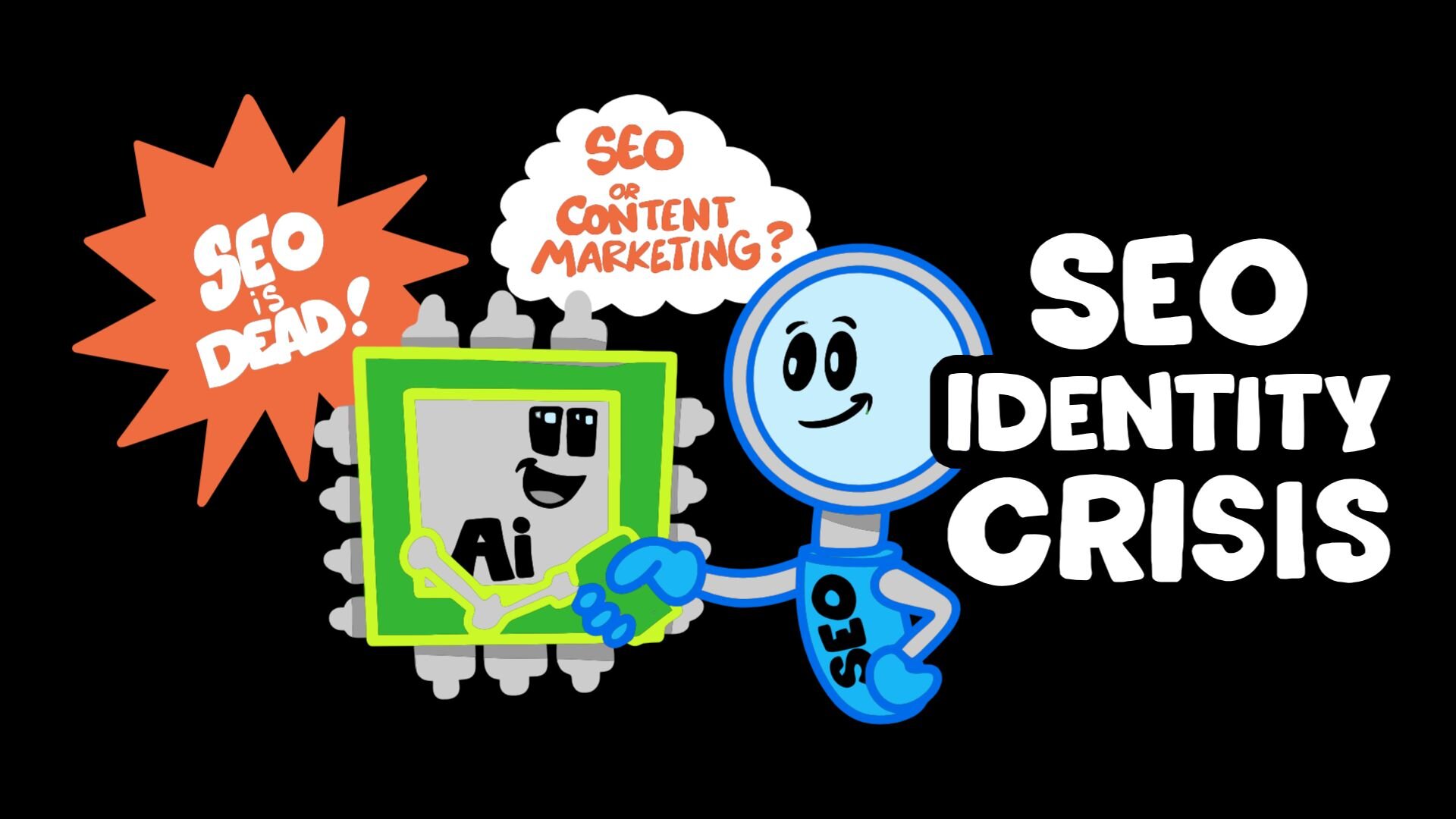
 Connect a Repo
Connect a Repo








